Originally posted on December 30, 2018 @ 9:37 pm
Grasping the fundamentals of SEO is key to excelling as a digital marketer. But what happens after you’ve mastered the essentials?
There are thousands of strategies you could learn in “advanced” SEO, and millions of niches which change how those strategies might apply. Rather than try to dive into a bunch of tactics that represent advanced SEO (and create an extremely long video) we think it’s significantly more valuable to focus on 6 core principles that underpin every advanced SEO campaign.

Principle 1: Understand & Leverage Google’s Existential Threats
For the digital marketer & business owners, Google is simultaneously a competitor and an ally in our quest to gain the attention of potential customers. As marketers we’re stuck in a Faustian bargain with Google where we give them complete access to our sites and optimize for their requests all in exchange for the hope of traffic.
That said, Google is a business.
Google’s business interests are going to affect how we benefit from their services. It’s important to understand Google’s business model and work backwards from there to gain the most value from the platform.
The majority of Google’s revenue comes from search. And more specifically selling ads to searchers. Having the best search engine (and voice AI tool) is fundamental to their existence as a company. Thus Google’s motivation is always going to be to give users the best answers to questions. We as marketers are the ones that provide those answers.
No site exists in a vacuum. While Google pulls us forward in quality (think about how they’ve forced content, speed, mobile etc) marketers also push the market forward through our competition. In that spirit there are three existential threats that will likely shape Google’s behavior over the next decade.
1) Google’s First Existential Threat: eCommerce Competition
Google is currently deep in competition with companies like Amazon (the current top dog) and Jet to create the dominant online storefront. Since 2015 in order to compete with Amazon, Google has responded by valuing content more highly on their platform while simultaneously selling ads.
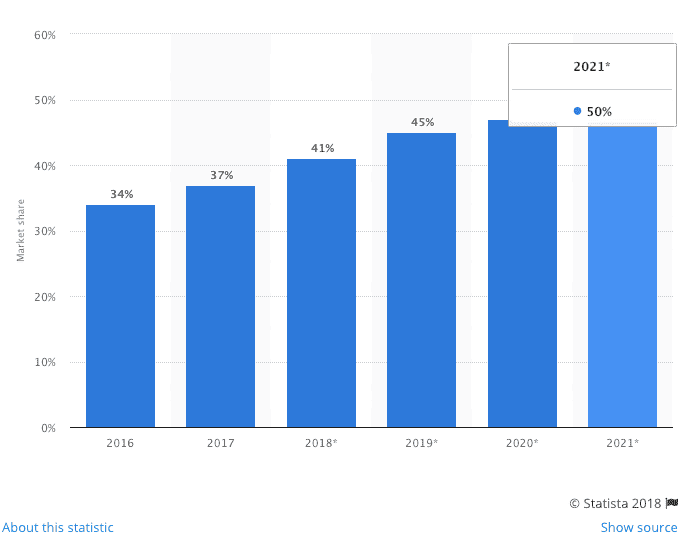
Source: Statista
Google “magnesium deo” you should see something like the following:

Notice how the first result is “6 Benefits of Magnesium in Deodorant | All Natural Deodorant Blog” rather than a product page. Even though it’s a clear product query. Google is valuing content around the subject.

Notice how a major chunk of the SERP after the third result is devoted to more content queries.
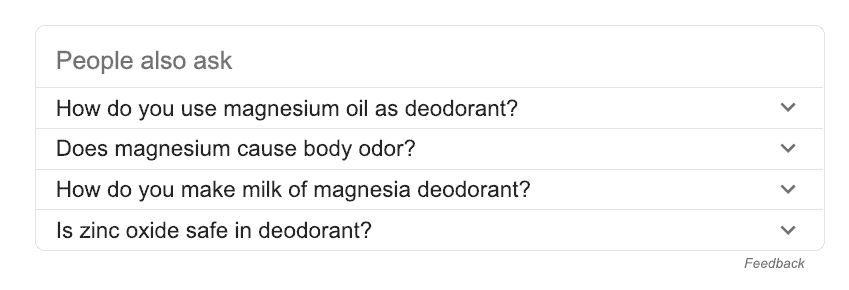
Notice how even Schmidt’s product announcement page (which has slightly more custom content) ranks with the individual product page for actual magnesium deodorant. Again this is a clear product query, but Google has modeled the algorithm such that content gets valued over a direct product page. (and many SERPs are worse than this, and almost all dominated by content)
Google overvalues content marketing so that it can sell ads above product guides.
Utilizing Google’s intention to sell shopping ads above content is a huge opportunity for savvy markets. Featured snippets and direct answers also present this same opportunity.
2) Google’s Second Existential Threat: Social Media & Influencers
With the ongoing death of Google Plus, Google is officially out of the social media game. When it comes to social media, Facebook, LinkedIn, Twitter, YouTube, and Pinterest are the key players. Instagram is currently the top dog when it come to influencing shopping behavior and society right now, as that’s where a lot of consumer eyeballs are. All of these services provide opportunities for both influencers and regular folks to recommend products and serves independently of the Google ecosystem.

What does this mean for Google?
If consumers are taking purchasing cues from influencers on social media or beauty influencers can move tons of makeup pallets direct to consumers (Gen Z’s QVC), they’re not going to be reading the guides you’re competing for on the SERP.
Google can’t really do anything about this. They’ve folded out of traditional social, so for inbound marketers that really means we have to do both. YouTube is arguably a social platform but its peripheral to the daily influence that Twitter & Instagram have. The algorithm does value authenticity and expertise, and it has for some time. But long term maintaining a strong social media presence so you can stay close to your customers is key.
3) Google’s Third Existential Threat: AI
The big specter on everyone’s mind is how artificial intelligence. AI and instant answers will instantly alter the search landscape. Planning a strategy around meeting the demands of AI search is a good bet going forward. Right now featured snippets and instant answers provide a huge opportunity to leap frog competitors with better optimization around them. But…
There will come a day where Google instantly provides answers without our results. Google is already heading towards “zero result” SERPs. This likelihood only underscores the importance of building a direct & meaningful relationship with your customers.
For marketers that don’t respond the entire marketing industry then becomes pay to play.
Principle 2: Balancing Competing Needs
No matter what kind of strategy you decide on, you’re always going to be balancing four factors: the needs of your client, the needs of the user, your ability to optimize with ranking strategies, and the big question: can we rank?
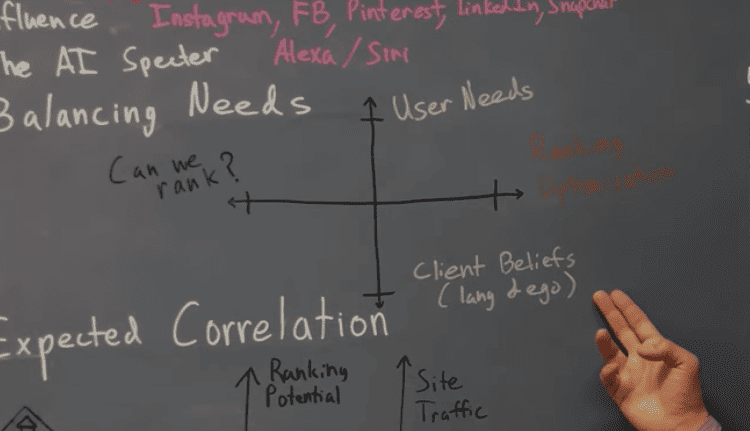
4 Factors SEO Campaigns Must Balance:
- Client needs -What the client wants ultimately drives where any project goes. Sometimes client goals are clearly driven by business needs, other times you’re dealing with vanity and an impossibility. You’re almost always going to have clients that are going to be wanting to do vanity or ego-driven projects. This is a part of the job of every digital marketer and agency out there. As SEO’s we either have to educate clients and set proper expectations/growth goals or fulfill ego goals and risk failure or getting a bad rap.
- User needs – We need to understand how and why our customers search. We almost always have to align how customers search (keywords) with what clients want or believe about that behavior. If those two are out of whack then an SEO campaign is doomed. The key question we always have to ask ourselves is, can we fulfill user needs? And on a micro level, does this page map to the intent of the searcher? If there is a mismatch here we need to fix it, create a page that works better for the term we want to rank, or find a new KW set to target. Additionally, pages need to have an excellent experience for consumers. Which again might be at odds with clients who like their site, or feel like it’s better than competitors.
- Ranking strategies – this is all the SEO strategies you know and love–image metadata, keyword usage, page titles, you know the drill. The big rub here can be that getting changes implemented can often come up with hurdles from internal dev departments. (which is why we almost always offer to implement on site ourselves)
- Can we rank? – Finally, this is the really tough one–ask yourself–do I believe that I can compete for a coveted keyword? The answer should be honest and forthright, considering carefully your resources and available content. You should never optimize a page for a keyword you can’t rank for. Getting 50 extra visitors (who btw want to buy) on a low volume keyword is infinitely better than getting 0 extra traffic from a high volume keyword.
Principle 3: Emulate Top Performers; Every Algorithm Has an Expected Correlation.
Expected correlation is the method by which search engines decide which part of the web page to rank highest in the search listing. Even though Google is now using machine learning algorithms to build algorithms they’re still feeding off the original algorithm. (with all it’s greatness and flaws)
We know what an algorithm will value based on the top results it returns.
When Google, Bing, or Amazon search returns top results for a query, we are seeing the algorithm’s “top picks.” This lets us know what we need to optimize for.
As far as Google goes, there is an expected structure of a website, where links flow from the bottom level (products/services) up to category pages (types of products services) to the tip of the pyramid, the home page.
Think of it like a pyramid, with the homepage of your website taking the point, and category, blog pages, and service/product pages creating the base on down. For inner links the homepage usually “correlates” here as the most linked to page within your site.

Coincidentally, there is often a correlation between homepages having the most external backlinks and lower level pages having few or none.
Given this expectation of structure by Google, “higher level” pages like homepages and category pages have the most capability to rank.
Here’s a helpful (if verbose) guide to how Google evaluates terms for their quality.
Every algorithm for search wether Google, Bing, Duck Duck Go, Amazon, Apple Music, or Spotify will have an expected model that will shape search and the market. It’s our job as SEO professional is to reverse engineer any algorithm we’re trying to exploit.
Principle 4: You’re Always Tied to Market Demands
Market demands and consumers will control any arena we are selling in. If we look at the marketing funnel, and I know we can talk about the user journey all day, but for the sake of simplicity the marketing funnel makes the most sense. Generally we can map keyword traffic directly onto the marketing funnel, with more broad searches at the top of the funnel, and more specific searches towards the bottom as people become more focused in what they’re attempting to buy.

This then causes the following relationship:
-
- Top of funnel keywords are best targeted by broad content focused on learning and brand recognition, blog posts, interactive content, eBooks etc.
-
- Middle of funnel keywords tend to be best targeted by category pages that encompass multiple products or services within a singular category.
- The bottom of the funnel is generally dominated by product or service pages.
At the same time, if you break down all the keywords in a specific category and plot lower funnel keywords to higher funnel keywords on the x axis, you’d get a curve with increased search volume similar to the one below. For most keyword niches you’ll also witness increased ranking difficulty as these keywords are getting more traffic. There will be some outliers, but this relationship roughly exists for keyword groups in all markets.
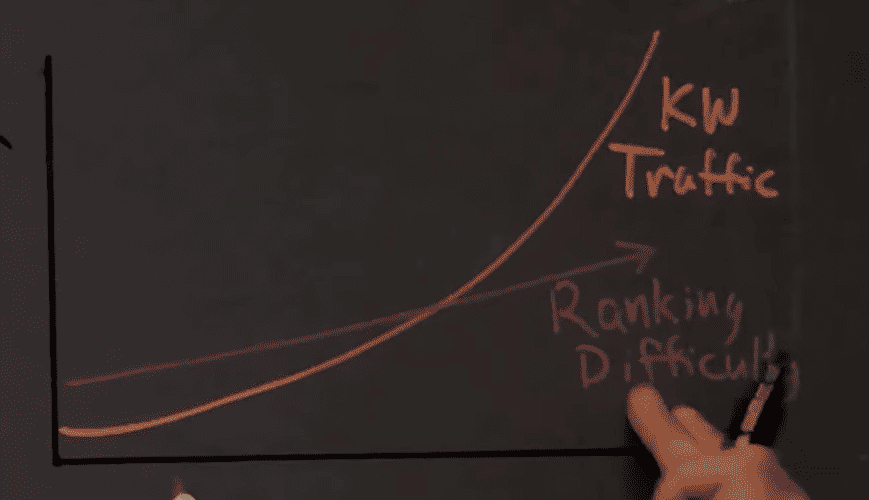
Thus when we’re talking about balancing needs and the importance of asking ourselves can we rank for this keyword we need to realize that all keywords we might target are going to have a specific stage of the funnel they target, which typically maps to certain types of pages, and those pages will have varying abilities to compete for those keywords.
Principle 5: Traffic Volume and The Quality of that Search Will Always Have an Inverse Correlation
As traffic volume for a keyword goes up the value of an individual user will go up. Consider the fact that someone who types in the keyword “backpack” ( 550,000 searches / month ) hasn’t narrowed down what they’re trying to shop for. But when someone types in “red leather laptop backpack” (20 searches / month) they have a significantly better idea of what they want. So even though it’s significantly less traffic each individual visit is going to be worth more per user. (though the net value of “backpack” may be higher overall)
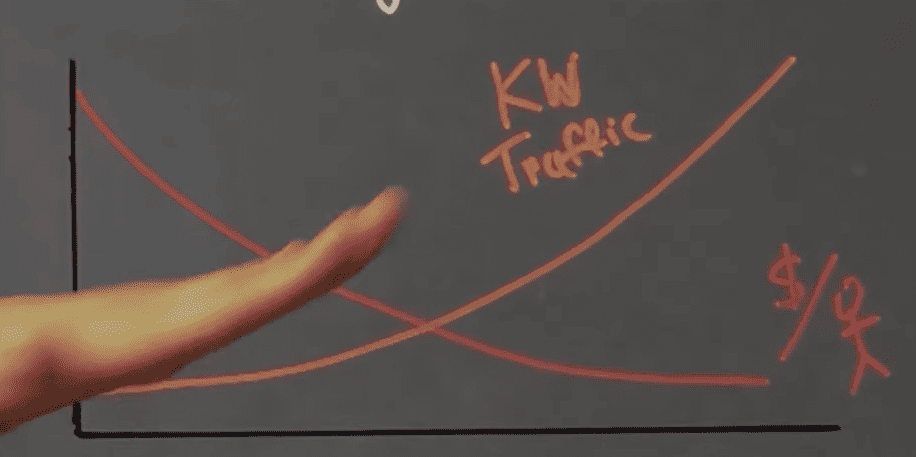
For individual businesses this means that we have to consider what capabilities our sites have to rank. And given our overall footprint decide to either optimize our site for lower volume more specific searches (where we have a chance to compete) or for higher volume keywords, where there may be more middle of funnel traffic we haven’t targeted yet.
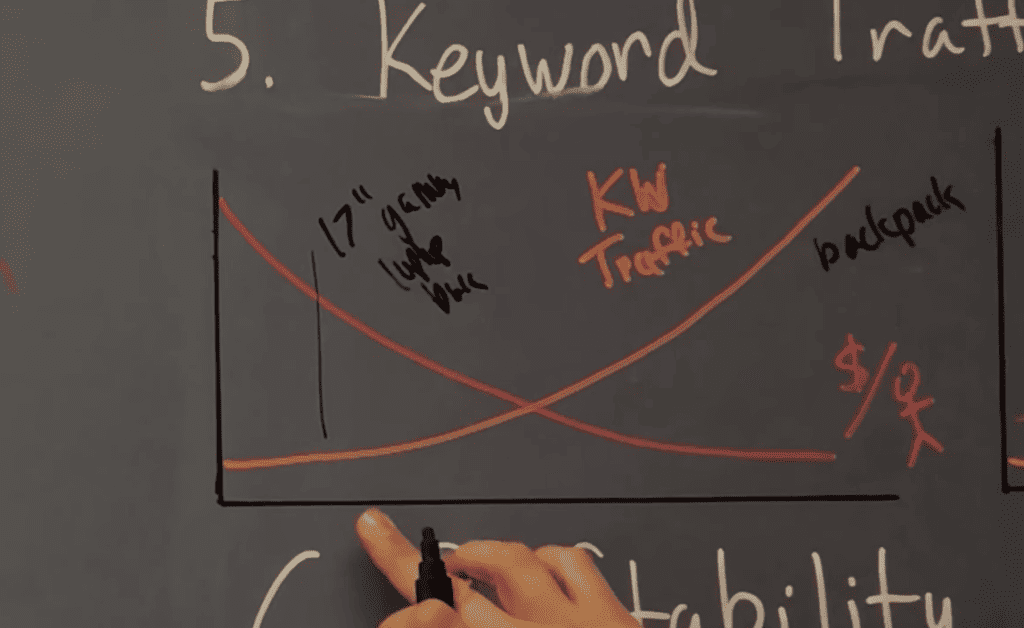
Generally speaking smaller and new businesses are better off targeting BoFu keywords with higher purchasing intent rather than higher volume and higher competition keywords. Mid size businesses can move their marketing in either direction, though targeting the bottom of the funnel tends to be more profitable than going after keywords higher in the funnel.
Principle 6: Determine and Target the Ideal Profit Optimization For Your Campaign
Given all the factors that have to be balanced, Google’s current favoritism at the time, and your capability to rank and optimize for keywords every SEO campaign will have an ideal profit optimization equation. Focusing on the best overall targeting strategy given these realities will always be the most essential part of a planning an SEO campaign.

